On tuesday night I was invited to pop along in Second Life to a Smarter Technology (sponsored by IBM ironically). Jon and Rissa kindly asked me to show and tell on the various elements of presenting in Second Life that I stumbled upon when preparing for the conference in Derry earlier in the year.
I basically had a pop at all the single screen powerpoints that we end up doing in world, just replicating what we do in offices. The space and dynamic nature of virtual worlds means we can do so much more. Part of what I do is wear the presentation elements, this is of course a hack around not being able to rez, but it works and has some nice side effects.
I used most of the flavours of the pitch that I wrote about here and yes we did get onto 3d printing. So whilst the presentation was about presentation styles I also tried to inject elements of the content in aswell so it was not overly meta.
I got Jon to set up my first page on the big screen, then also to break the build with a long wide collection of slide similar to the ones that can be seen on IQ which is a presentation trick people use to show the entire pitch and move along it (which is well on the way to breaking the PPT metaphor)
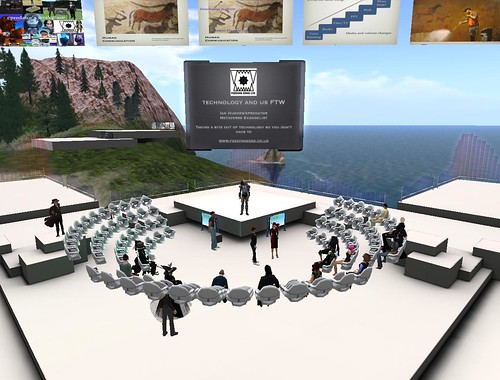
I had also built some examples of the quest for 2d whiteboarding (which we still need) but how that can be done in a different way in these environments, we have dynamic creation, we have 3d immersion why stick to 2d?
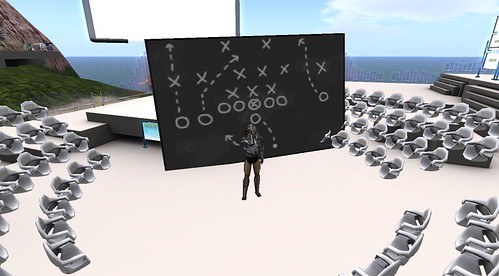
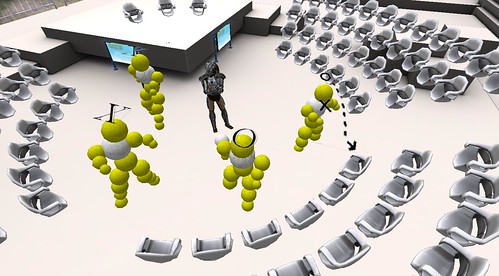
(These shots were from when I popped along to check the space out so I did not grief people too much)
Still the favourite was the giant hands though I think.

Photo by Ishkahbibel
So a huge thankyou to all who tuned in or attended. The discussions and questions we great. It was mixed mode in that text flew past and I answered mostly by voice, something that still takes some getting used to. However the sheer amount of text activity meant I knew everyone was there 🙂
I know right at the end we descended into Mac/Iphone/Xbox/Windows 7 discussions but its kind of like the parrot sketch for Monty Python its part of a gathering to discuss such things.
If anybody missed an answer to a question they asked, or I missed the question altogether in the live flow then please feel free to ping me inworld, or comment here or twitter or….. I am not hard to find 🙂
IQ and Hursley are still there in world, there are a few plots left to rent on Hursley and the half a sim on IQ is also available though it has a furrie colony borrowing it at the moment let me know if you need some SL space.
Evolver Avatar on the Iphone via Unity3d
It has been a busy week for travel and meetings this week. However in the gaps between pieces of work I have been exploring what I can do quickly and simply with the Iphone 3GS. I had been looking at the various 3d toolkits, doing model import by hand.
In the end it struck me as obvious to use unity3d iphone as this just takes away the underlying hassle.
Using unity3d it was very easy to bring things in such as my Evolver 3d model into an app and make it draggable and rotatable using touch. This took approximately 10 minutes to do. I spent more time wondering about the various particle effect parameters than anything else.
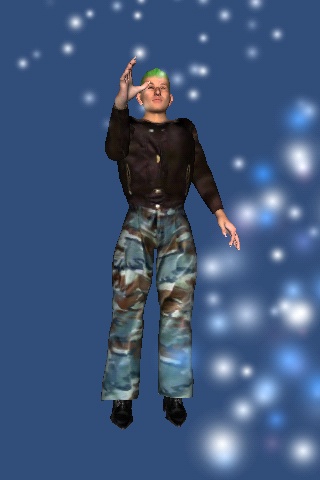
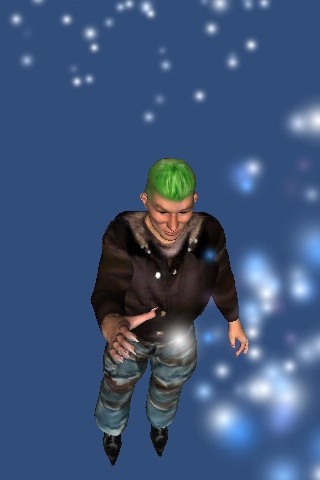
Obviously you can do a whole lot more, but it is a massive leap in productivity. It does not require any other strange contortions or going via windows in order to get a good 3d model in.
There are a few quirks in the tool chain but things like the Unity Remote application that lets you see whats going on via your Mac and streaming media from the iphone are great. (Hint if you cant get unity remote to compile and deploy just grab a version from the iphone store (lost a few minutes thinking about that!)
I know the hardcore techs will be saying you can build all this from the various bits, cocos, SIO2 etc but I have had to do that one to many times and I want to explore the ideas for applications rather than the guts of the platform.
Just having this in my hands and using it has created rather a long list of “I wonder if…” apps to create. Including using the touch interface to control some Opensim objects.
Sculpty fingers – Crossing worlds – Moving data
I just bumped into the excellent iphone application called Sculptmaster 3d by Volutopia it lets you build and manipulate a 3d model using touch and some simple tools. You can then take that model and export it as an OBJ file via email or just snapshot it.
It produces very organic results, it feels like modelling with clay in many respects. The key for me is that is is using a different interface, in this case the iphone. This makes it very accessible and available to people who want to just have a quick go.
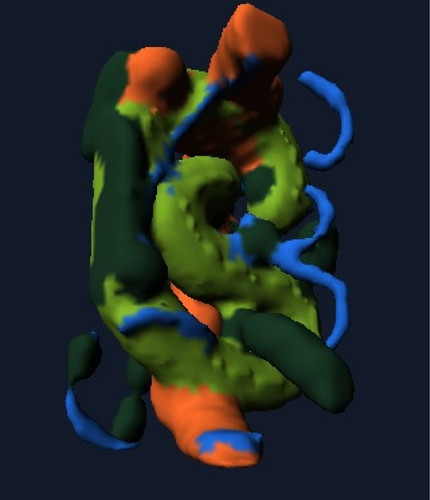
Given what I was up to yesterday I had to try and export it and upload it to 3dvia, which of course works fine.
Once it is there in 3dvia it is shareable via the 3dvia mobile app, just search for handmade by touch as the model name.
Again I know this is not live augmented reality but I added the sculpture to my garden.
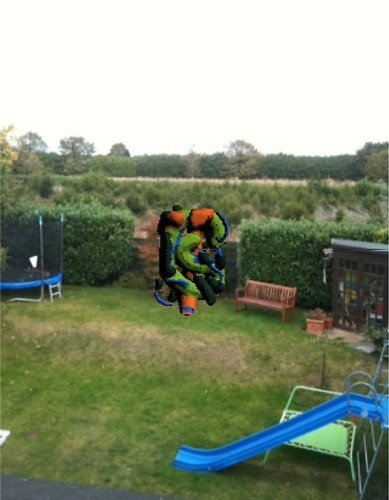
That geotagged photo is then actually appearing in the live Flickr Layer in Layar so its another wheel within a wheel.
This is interoperability. Data and presence of that data is able to flow, people allowing import and export of user generated content, either live, or in more old fashioned batch means that we can combine applications and try ideas out instantly.
This sculpture could of course now be manufactured and created on a 3d printer, the data pattern could be sold, licenced adapted, dropped into other virtual environments. The loop is complete.
Augmenting Augmented Reality
Whilst having a god with the 3dvia iphone application I decided to see if I could use my Evolver model and upload it to 3dVia, and get myself composited into the real world. The answer is of course you can its just a 3ds model! However I then wondered what would start to happen if we started to augment augmented reality, even in the light sense. I had done some of this with the ARTag markers way back on eightbar. and also here putting the markers into the virtual world and then viewing the virtual world through the magic window of AR.
That of course was a lot of messing about. This however, was simple, handheld and took only a few seconds to augment the augmentation.
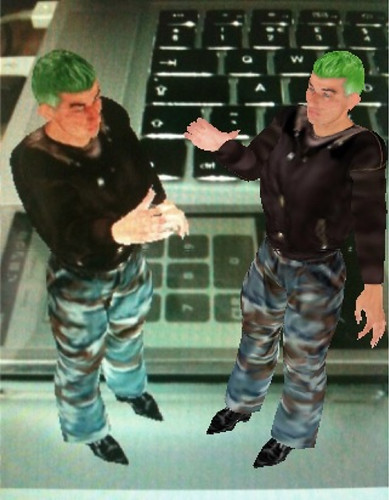
Or augment my view of Second Life.
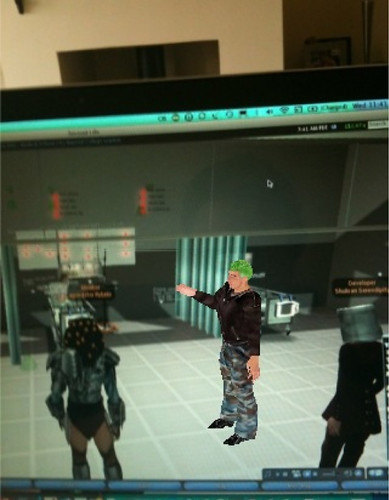
So these are the sort of live 3d models we are likely to be able to move in realtime with the 3d elements in Layar very soon.
Likewise we should be able to use our existing virtual worlds, as much as the physical world to define points of interest.
I would like to see (and I am working on this a bit) an AR app that lets me see proxies of opensim objects in relative positions projected in an AR iphone app that lets be tag up a place or a mirror world building with virtual objects. Likewise I want to be able to move the AR objects from my physical view and update their positions in opensim.
All the bits are there, just nearly linked up 🙂
We know it works taking real world input and injecting that in a virtual world (that was Wimbledon et al.) or marker based approaches such as I did over a year ago with my jedi mind numbers
I am thinking that between things like the Second Life media API’s or direct Opensim elements knowing what is going on in the world, with a combination of sharing services for models like 3Dvia, and wizards like Evolver all jammed into smartphones like the iphone we have a great opportunity.
Layar reaches the iphone – AR for everyone?
You can tell I have a 3GS in my hands now, a few more hands on tests of apps. I had been waiting until the Augmented Reality service linkages were unleashed. Today it got even better with the Layar the AR browser appearing for download. It works really well, with either simple searches of google showing up in your heads up display as you pan your iphone (or Android phone) around.
The key is of course the layers. Different providers providing different sets of data, from twitter to flickr and even wikipedia.
It is so simple and stunningly effective.
Even better though (and this saves me a job having to do it) is that they are going from static pins and icons to animated 3d objects placed in AR space in November
Now surely this is where we get a to define the objects in relative space and store them in opensim as the source for the layer. I am thinking in particular of things like mirror world builds being able to easily be mapped to physical space. Tagging real world places so people can visit them in the mirror world and vice versa.
Even the elements of slight more obscure things, think of some very good blended real and virtual world applications (the list of which in my head deserves its own post very soon).

Easy, free, relatively accessible with a popular device set. I think Layar has just set themselves up as the the AR equivalent of Second Life on virtual worlds, or Google in search.
3dVIA on the iphone
This video (thanks to @andysc for tweeting it) shows the 3dvia iphone browser for models in action, and providing a degree of augmented reality. The ability to view and examine3d objects on with the touch interface of the iphone is the important part. The elements of superimposing on a static photo is really AR lite. At the end the piece that is thrown is as a joke is really something that is happening with rapid fabrication.
So now someone needs to combine the realtime AR elements of video with the excellent modelling renditions from 3dvia. Hang on, I have an iphone now and I am a registered developer. Hmmm…. to the lab.
Here is a car in the palm of my hand.

Washing away cave paintings – Live
This week sees me on the road for two presentations of Washing Away Cave Paintings.
The first is tonight for a joint BCS/IET branch meeting in Swindon to IT professional and Engineers.
The second is on Thursday on London at Workplace Trends. (Somewhere I spoke last year, so hopefully I don’t cover too much of the same ground). This time the audience are property and real estate managers for business.
The same presentation, and with a slight addition from the original one back in march at the Derry Awakening Creative Entrepreneurship. The addition being a picture of presenting the same presentation in Second Life is a different way and a Kzero chart.
(Not to self really must do a voiceover for this one day!)
The message fits people, as much as the specifics of a job role or area of interest. I think the diversity of audiences and the positive feedback from them (so far) shows that this still has a way to go.
It is not just about virtual worlds, nor about the tech to operate with them. We are all experiencing a change to work and social life where the tech is a conduit. Whilst it has fashions, trends and quirks we are very much more connected to a more diverse set of people than at any time in human history.
Augmented Reality Magic
I just bumped into this magic video using some of the sort of Augmented Reality things that we are seeing emerge for real on devices like the iphones. The award winning magician Marco Tempest is making some of the close up magic we see on TV start to incorporate AR, but not in a way that is just cheating with a camera trick. Obviously at the moment some of the elements are clever live editing into the performance, but it is the more descriptive and engaging visualizations that help tell the story of the pack of cards that prove the most interesting.
The underlying techniques and tricks may well be the same ones used by many magicians, but the techno showmanship really appeals, whilst also being actually possible right now.
Virtual goods for marketing engagement
As I blogged on epredator.com I am very much looking forward to the driving fest that is Forza Motorsport 3 (Xbox 360) this month. However I was just struck by how interesting and experimental some of the marketing in and around the game is. Forza is not just about driving but about the cars as content. User generated paintwork and art on the cars are tradeable as are specific tuning setups. The car is the container for the content. Many games recently have allowed early downloadable pieces of content custom to a particular provider or pre-ordering allowing you access. This particular example is a twist on that. (I am not saying its a first, but its certainly not the norm)
So the offer is that if you go to a blog article and comment by joining in on the “What are your top ten driving songs” you get to receive this Zune branded Audi when the game is released.
So we have a marketing stream that is engaging us to join in on a blog, but talking about music as it relates to cars, and is “sponsored” by Zune the Microsoft music player. On receiving the car we then have a Zune advert, that is in fact limited edition, that we may choose to use in online races. This being an example of owning the 3d content, but being able to atleast show and use it with other people who don’t own it. Also the songs will start to form driving playlists on the Zune marketplace.
In exchange for being interested and sharing, we get to feel engaged yet also become the advertiser for the Zune. It does not leave me feeling exploited or sold too, its a great pattern, and now I am blogging about it. UPDATE: I forgot to mention the irony or otherwise that I opened my iTunes when compiling my list of top ten favourite driving tunes for the competition entry.
The article if you want to join in and have an Xbox Live Gold account is here
Explorers, Anchors and Historians – Who is the trouble maker?
Whilst out cycling and dealing with a rather annoying puncture on the cliff top overlooking the Solent I was struck by the description of a concept that I needed to think about some more and then share. The solent has often been the gateway to some great exploration, it has some significant history around Portsmouth and Southampton and it is also a safe port for many a vessel.
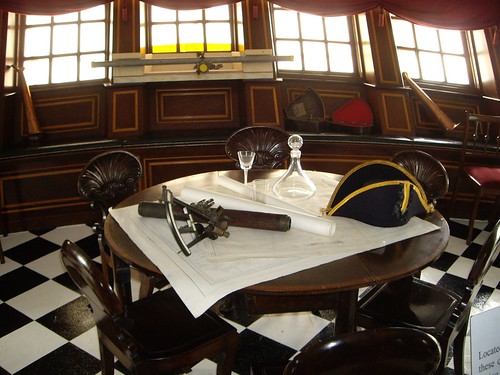
This trinity of classification seems to apply to the adoption of new ideas, new ways of working, new products.
The Explorers go out and discover, they invent, they sing the praises of the new world. They risk a great deal, but the risk is the reward for many.
The Anchors offer a safe haven, keeping things in place, giving an explorer somewhere to launch from and return (triumphantly) to.
The Historians remember, capture keep and preserve both the good and the bad. They keep old ways of doing things alive.
We need all three, but sometimes the system goes out of balance and that can be any one of the set but the most frequent in my experience is the following.
The Explorers head out, discover and return. The Anchors worry about having to haul anchor, find ways and means of not accepting what the Explorer has found. The Historians back up the Anchors with the “this is the way we have always done it” or “it did not work last time so…”.
Generally the Explorer will battle with the Anchors to justify the expedition, but a strong Anchor just has not reason to move.
In reality the Explorer should target the Historians, showing them there are other ways of working to preserve, new exhibits and generally forget the Anchors altogether.
Why does this make sense, well if the Anchors are in control the system stops completely. The explorers wont go out and find anything, the anchors wont move on and so the historians have nothing to preserve as old. Everything will remain static and the same just as the anchor needs it.
If the Historians demand history to record, and the Explorers find new ports to anchor in and provide that change then the system works.
So, and excuse the pun, don’t let the Anchor’s drag us down.
It is not the free and fancy explorer that is the trouble maker here, nor the Historian seeking to preserve the old ways is the Anchor.
I speak as an explorer and sometime historian, which of the three are you?

